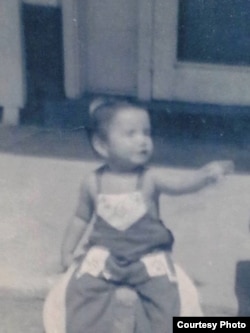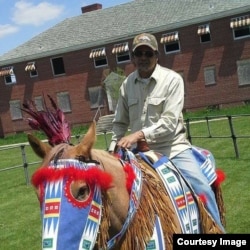Conrad Eagle Feather, a Sicangu Lakota, was only three when he was taken from the Rosebud Indian Reservation in South Dakota and adopted by a non-Native farming family in the state of Nebraska. His three sisters were removed to separate families.
He recalls a childhood with little joy.
“They used us for farm labor,” he said, detailing a list of chores that began before dawn and continued until bedtime. He said he still bears the scars of physical abuse.
“For every sin I had committed according to the Bible, I got one strike with whatever they had in their hands at the time — a garden hose, a broom handle, a wire hanger,” he said. “And all the time, they used to tell me, ‘Who knows what would have happened to you if we hadn’t saved you?’”
He gleaned little about his heritage from schoolbooks, which he said reinforced the message that he was “no good.”
“Can you imagine an Indian kid sitting in a classroom with all white kids, and your history book is telling you what dirty, filthy, heathens Native Americans were?”
At 16, he ran away from his adoptive home.
“I was really confused and lost as a young adult, because I had memories prior to the adoption. I knew I belonged to somebody else. But it was all kept away from me,” he said.
In the decades that followed, he moved from state to state, served in the military and worked as a custodian, always struggling with depression and alcoholism. And always dreaming of returning to the reservation to find a sense of belonging.
Robbed of identity
For generations, the U.S. government turned to forced assimilation to solve what was generally called, “the Indian problem,” that is, how to govern Native Americans, lift them from “barbarism,” reduce their reliance on federal funding and guarantee their loyalty.
Beginning in the 1880s, children were forcibly removed from their homes and placed in out-of-state boarding schools, where they were forbidden to practice their cultures or speak their languages. Many suffered years of sexual, physical and emotional abuse. This era nearly destroyed the extended family system.
In the 1950s, the U.S. created a relocation program, providing Native Americans with funds to leave the reservation and resettle in select cities. And through another federally funded program, the government prompted adoption agencies to target Indian children for adoption outside their culture. As many as 35 percent of Indian youth in some states were adopted into white families before Congress passed the 1978 Indian Child Welfare Act, which set limits on removing Indian children and requires them to be placed with extended family, wherever possible.
Even so, some states continue to skirt the law. The American Civil Liberties Union reports that since 2010, welfare workers have removed more than 1,000 Native American children from a single county in South Dakota, placing them in foster care, “disproportionately in non-Indian homes.”
Culture shock
Eagle Feather returned to Rosebud 17 years ago. But the reunion was not what he expected. “Because I didn’t speak the language, because I didn’t know the culture, I was called ‘white’ by my own blood relatives,” he said.
He also faced daunting legal challenges.
“When I was adopted, they changed my birth certificate and gave me a different name. I had to go get a judge’s order to get my birth name back,” he said. “Later, after my mother died, I went to the tribe for assistance. She had been an enrolled member there, but the tribe said, ‘Who are you? We don’t know you.’”
Reunification can be disappointing for birth parents, as well, said Sandra White Hawk, also a Sicangu Lakota adoptee from Rosebud now living in Shakopee, Minnesota.
“It’s not that our families don’t love us or want us,” White Hawk said. “It’s that both the child and parent has be deeply impacted by historical trauma on many levels. Often the birth relatives experience shame or confusion as to how to talk about what happened. The adoptee, if reuniting on the reservation, is stepping into a culture very different than the white culture he or she was raised in.”
To help ease that transition, White Hawk founded the First Nations Repatriation Institute (FNRI), which works to mend family relations, help adoptees reclaim their Native identities and educate courts and social service and mental health care providers about tribal traditions and values.
Elsewhere in Rosebud, groups such as Tiwahe Glu Kini Pi ("Bringing the Family Back to Life") provides culturally relevant services to Lakota youth with serious mental health issues, as well as their families.
Five years ago, Eagle Feather, then around 50, stopped drinking and decided to enroll at Rosebud’s Sinte Gleska University, where today he is working toward a bachelor’s degree in human services. His goal is to work as an advocate for tribal children “to help keep them here, if that is the best for them.”
A turning point in his own healing came two years ago, when he conducted a research project on Native American adoptions.
“The whole time I was growing up until I was probably in my mid-20s, I thought I was the only individual out there, me and my family, that ever got adopted,” he said. “Now, I know there are thousands and thousands of individuals who have gone through that same exact thing.”










